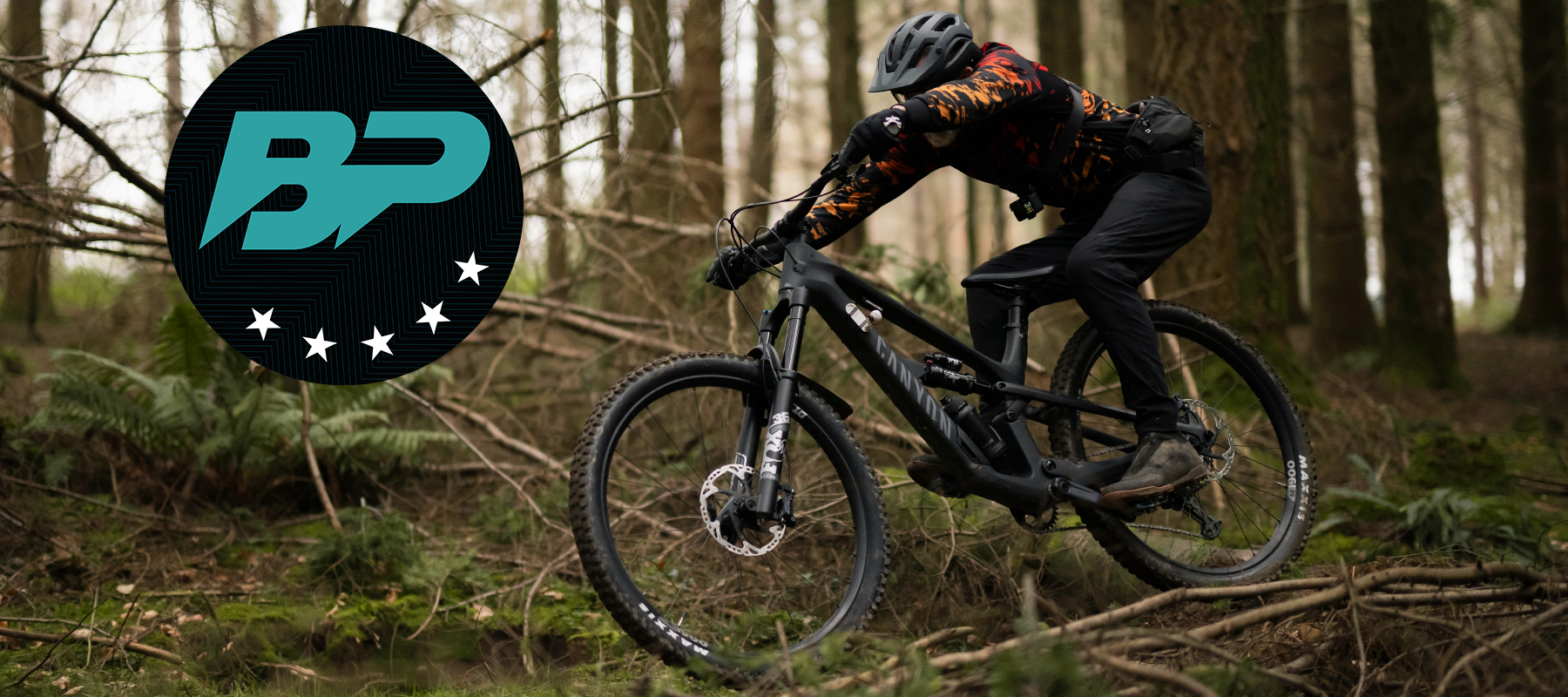Bike Perfect Verdict
Despite the name our website, no bike is perfect, but Canyon’s new Spectral is about as close as you’ll get when it comes to all round joy riding at an excellent price.
Pros
- +
Premium frame feel and details at a bargain price
- +
Excellent adjustable all rounder geometry
- +
Outstanding performance for price component selection
- +
29er or mullet compatible chassis
- +
Adjustable steering stabilization
Cons
- -
Not available from shops
- -
Relatively heavy for its travel
- -
Big senders might want to add a shock spacer
- -
Initial rattle is irritating
Why trust BikePerfect
Canyon’s new Spectral doesn’t look much different to the previous bike but adds internal storage, adjustable steering stabilization, consistent sizing steps and subtly altered frame and suspension dynamics for more pop and play. There’s some delicious detailing to be found despite the discounted bike matching pricing too.
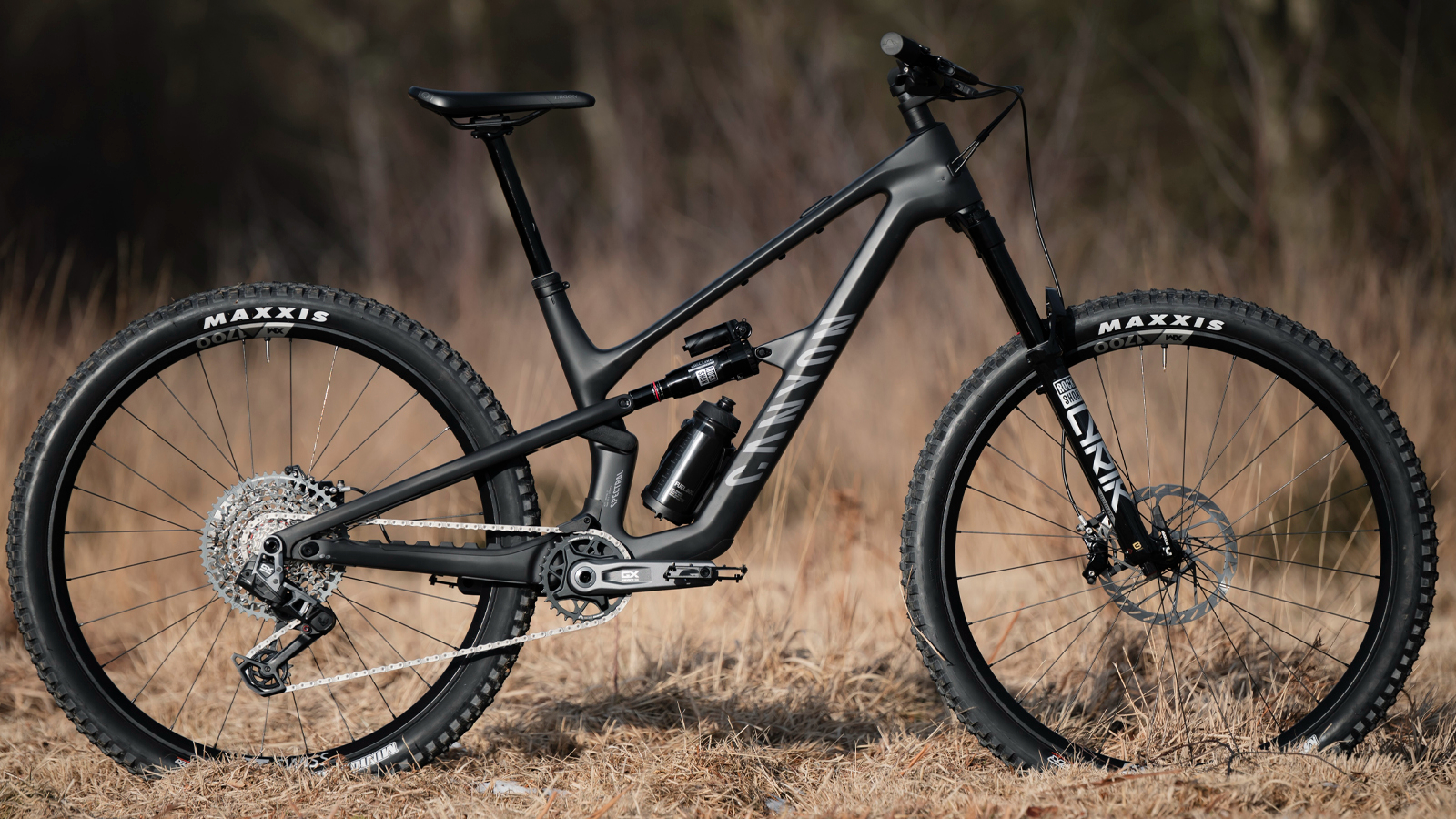
Design and geometry
Canyon have kept the shock under top tube, four-bar design of the previous Spectral, but they’ve added internal downtube storage via a neat ‘knee lever’ closed hatch. This also carries the main bottle mount which can fit a standard bottle on all sizes, but there’s also a custom 850ml frame filler bottle option available. There’s another accessory mount under the top tube and an optional fast access mini-tool mount in front of that. You can bolt a modular chain guide mount to the bottom bracket and a weatherproof tool bag for the internal storage can be added at checkout too.
All pivot bolts thread into replaceable inserts and the new stiffer linkage is super neat in the way it blends into the frame. That’s accentuated by hidden pivot bolts and the way Canyon keep the seat tube mid section and rear frame matt black even on colored bikes. Entry ports have been made neater and there are internal guide clips for hoses and cables. There’s a ribbed chain stay protector which extends around the chainstay head to form part of a clever interlocking mud protector design over the main pivot. The double-sealed suspension bearings are secured with a single piece bolt, washer and seal piece to reduce weight. The rear axle uses a ‘Quixle’ pop out lever so you only need a hex key for the fork. Despite the addition of downtube storage and increase in reach, Canyon says the frame is only 20g heavier than the previous frame at a claimed 2,602g for a medium*.
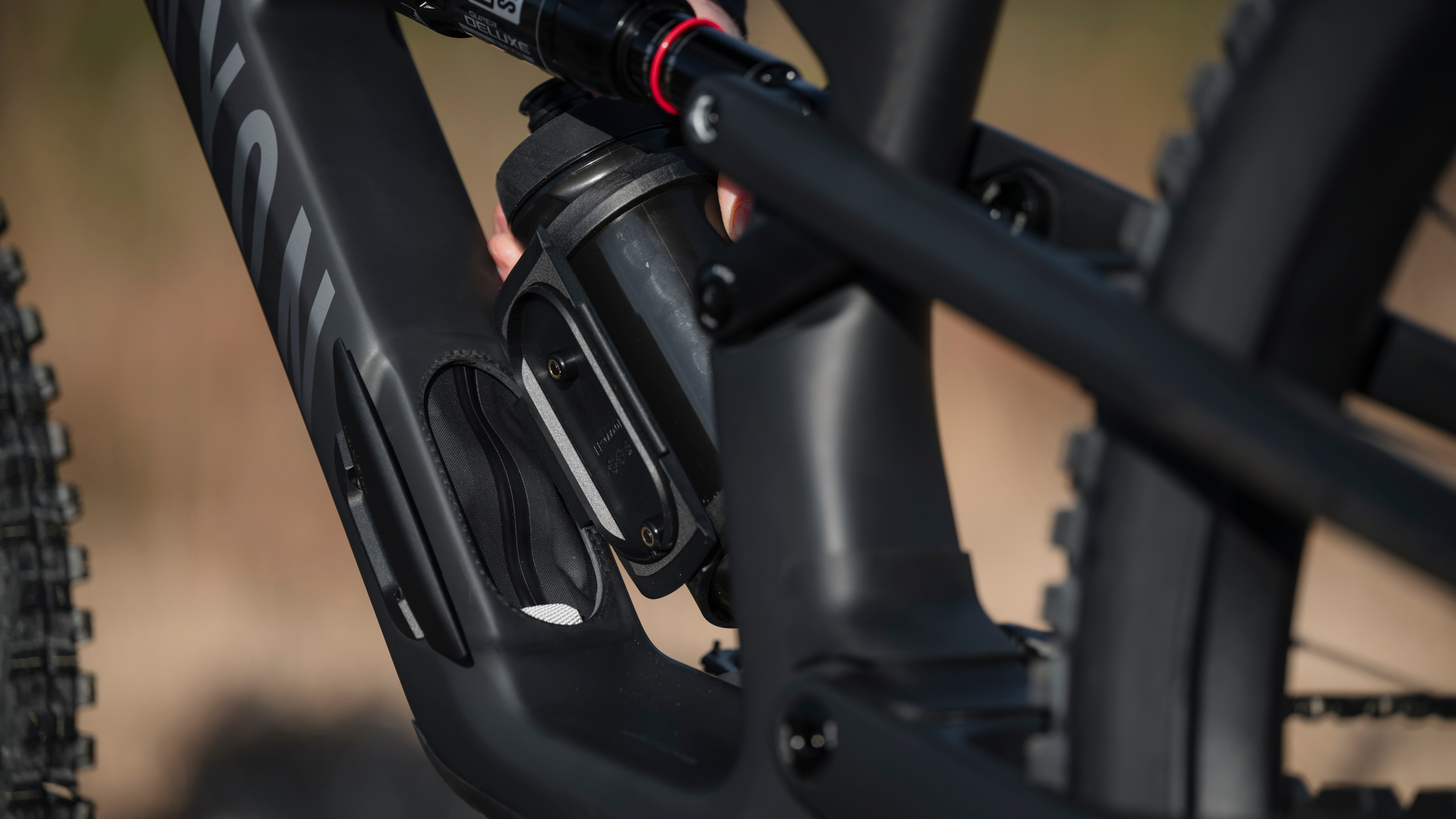
The kinked downtube gets a single sided rib to boost stiffness without creating a lake and the seat tube has been upsized to 34.9mm to add seat post stiffness, but reduced in length to increase shaft space. Top tube and downtube have been widened but reduced in depth to maintain overall front triangle stiffness despite the hole cut out for the internal storage. The rear stays have been slimmed down to add more spring and increase heel clearance too, but the frame still gets Category 4 ASTM ‘Enduro’ clearance and a lifetime manufacturing warranty.
Geometry is rationalized rather than radicalized with consistent 25mm reach steps between sizes which meant a medium frame now fits me great with a 475mm reach that would have been a large before. Reducing travel from 150mm to 140mm with a shorter shock also allows an XS size option with a 27.5in rear wheel. The 76-degree seat angle and 64-degree head angle are unchanged, but you can slacken both angles half a degree by rotating the eccentric chip in the rear shock mount. Another eccentric chip ahead of the rear axle lets you change axle height and effective chainstay length to keep key numbers stable if you switch to a mullet 29 / 27.5in wheel build, or pick that option when you buy. While BB height is 5mm higher on paper at 340mm, reduced anti-squat means the dynamic ride height is similar on the trail.
Steering gets an extra, adjustable stabilizing boost from the unique elasticated KIS sprung loaded strap that fixes onto the steerer. The tension of the spring and therefore the amount it tries to recenter the wheel can be adjusted via a slider on the top tube. Alternatively if you want a pure steering feel you can remove the KIS hardwear and just fit the blanking plate supplied. There are subtle changes to the coil shock compatible suspension geometry too, which I’ll talk about later.
Incidentally, the Spectral CF 125 and alloy framed 160/150mm travel models carry on for now, with fresh colors and updated spec but no chassis changes.

Components and build
Canyon have slimmed down their Spectral range down massively with just four spec levels in Europe. The £3,299 / €3,399 CF 7 tested here, £3,849 / €3,999 CF 8 CLLCTV with mullet wheels and coil-sprung rear shock, £4,799 / €4,999 CF 9 and £6,699 / €6,999 CF LTD. Only the CF 7 at $3,699 and CF 8 CLLCTV at $4,199 are available in the US initially.
The CF7 is a who’s who of cost effective ‘do you really need more kit’. The Fox 36 Rhythm fork is simple but succulently smooth and pegged back to 150mm of travel from the 160mm versions used on the previous Spectral. The Float X shock gets a lever actuated ‘firm’ setting for smooth climbs and a ‘piggyback’ oil reservoir to keep performance consistent on longer, hotter descents.
Shimano SLX gears and brakes are a byword for durable functionality and 203mm rotors front and rear give the four-pot brakes serious poke. Chunky Maxxis DHR II tires front and rear mean you’ll never be short of grip. The reinforced EXO+ carcass on the rear is a nice touch too, especially as recent carcass changes have made that tire more supple. While the CF 7, 9 and LTD come twin 29er as standard, you can opt for a 27.5in MX / Mullet rear wheel (which come as standard on the CF8) at the checkout.
The 31.8mm bore Canyon G5 stem is aesthetically divisive and comes in 40mm for all sizes but keeps the reassuringly big clamping bolts hidden well out of harm's way. Canyon have released a 3D printing file for a stem mounted multi-tool mount if you fancy a DIY upgrade. The bar grows to 780mm from 760mm on the M to XL sizes. Dropper post strokes are size specific too, growing to 230mm on the XL frames.
*Despite similar builds and a very similar claimed frame weight, complete bike weights have increased around 500g over the previous bikes, so the Spectral is relatively heavy for a 150/140mm travel carbon framed bike.

Ride, handling and performance
If I hadn’t had it on the scales though I’d have probably said the opposite was true. While the previous Spectral CF was a brilliantly capable and well balanced bike I always found it a bit blunt and lifeless on the trail. Even the short travel Spectral 125 didn't deliver the extra sprightliness I was hoping for either. In contrast, the new Spectral feels super playful and alive straight away, even in the base model. There’s no doubt that most of that comes from the reprofiled frame elements adding spring in the rear while keeping the front end hench. Other very experienced, premium frame pilots also commented that it was one of the best feeling frames they’d ridden at any price.
The suspension also came in for massive praise. Again, the stiffer linkage deserves some credit in reducing side loading across the rear shock. This minimizes stiction (the inherent resistance to movement caused by seal and internal bushing drag) in the Float X shock to the point where it feels like it’s sat on a trunnion and/or bearing mount rather than conventional composite eyelets. Canyon have also reduced the amount of ‘anti-squat’ (how much the suspension stiffens under pedaling) and ‘anti-rise’ (how much the suspension extends when braking) on the new Spectral to increase sensitivity under power. They’ve lowered the suspension leverage at the start of the stroke too so progression is more linear. While it was really hard to get the old bike to full travel, the new suspension also pushes to the end of the stroke much more easily so while it’s physically shorter travel, it actually feels like there’s more movement of the rear wheel.
The result is a bike that melts into the trail like butter on hot toast, with excellent traction and supple comfort whether descending or on the gas. In fact, it’s so smooth that although I’ve got a Fox DHX coil shock ready to slot in, I haven’t actually felt the need. However, the real magic in Canyon’s new Spectral suspension character is the mid stroke feel. While reducing anti-squat will generally make a bike feel soggy and flaccid under pedaling, and you definitely lose some sharpness from the first phase of the pedal stroke, the mid stroke is supportive enough to keep it surprisingly stable overall. I certainly didn’t feel the need to flick the compression lever into ‘Firm’ on off road climbs and the supple nature also gives it impressive tenacity on technical climbs.
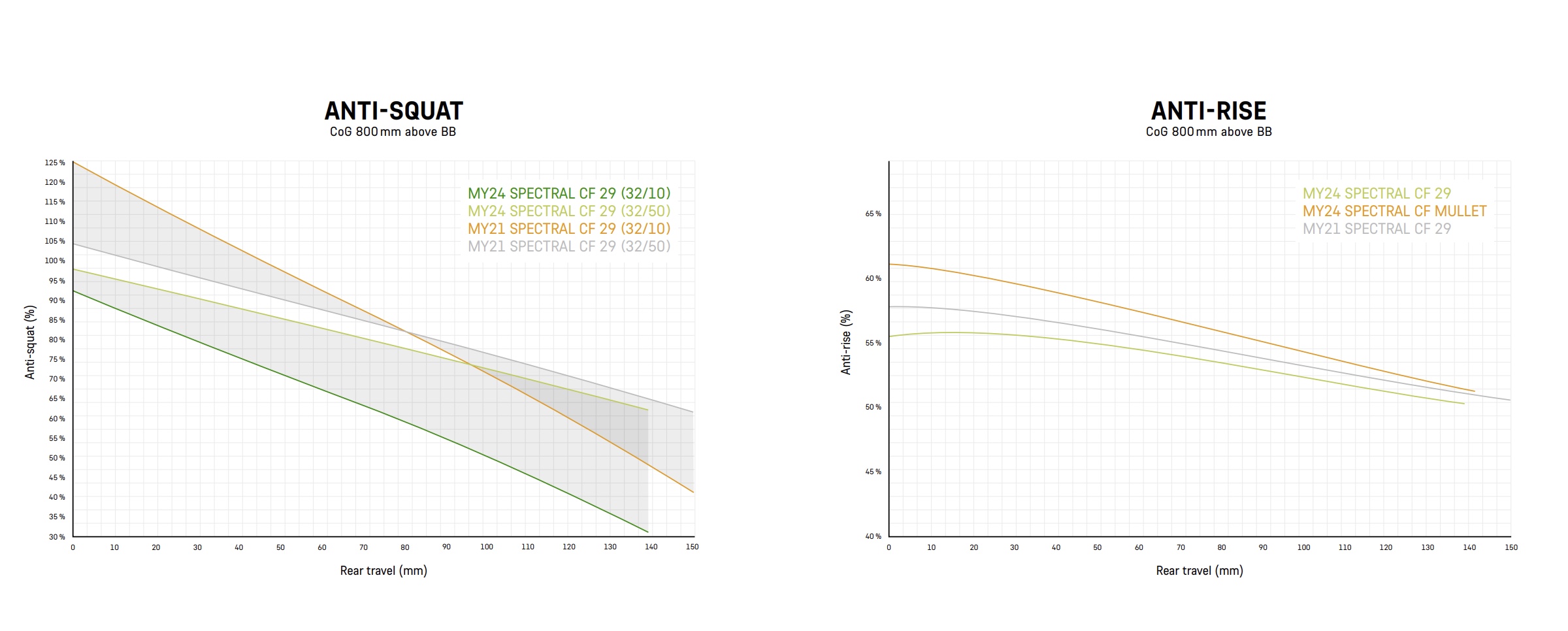
As I said at the start, the mid stroke and frame spring also combine to create an absolutely joyful spring and pop to the bike. It’s enthusiasm to pump, push, load and launch off every possible part of the trail is totally infectious, to the point where my riding regular riding mates were commenting on how much I was clearly enjoying the ride and being a lot more dynamic and daft that normal. Even when I pushed too far for my skill and the shock hit full stroke, there was no ugly bottom out recoil or clunk either. Regular big senders may want to add upsize the volume spacer in the shock so they’re not constantly bouncing it off the stops though.
As much as Canyon’s suspension engineers deserve credit for making the relatively simple Fox Float X shock feel fantastic, Fox get all the plaudits for how well the Rhythm fork up front matches the rear end. What it lacks in tuning opportunities it makes up for in set and forget suppleness and excellent overall balance from truffle hunting traction to swallowing ugly nose landings without choking. Canyon do deserve a shout out for sticking with slimmer 31.8mm bars to reduce wrist sting on long, rocky descents that will eventually start to overwhelm the fork.
The big 200mm rotors also reduce finger effort and arm pump on long and/or heavy braking descents too, although most riders could probably downsize to 180s if they want to shed some weight. The Shimano SLX shifting also feels slightly clunkier than analogue SRAM or anything electric but it always gets the job done and from experience, it’ll continue doing that far into the future however badly you treat it. The Maxxis DHR II tires are stubbornly grippy in all conditions too, but their slow roll does put a dampener on the ability to hustle the bike hard on rolling or flat trails. Lighter wheels are also an obvious upgrade for anyone wanting to boost agility and acceleration, but again you won’t find anything more reliable at this price point that DT Swiss.
While I didn’t try the coil shock, I did make use of the easy ability to switch to an MX/mullet format. As you’d expect, it made the Spectral even more exuberant, scrubbing the rear wheel in tighter on turns when it held traction, or spilling it out wide speedway style when I really loaded the front to bite it right into the apex. While the flip-chip on the chain stay doesn’t change geometry it does increase progression to help the smaller rear wheel skip over holes and square edges it might otherwise hang up on or drop into. As a result, I’d certainly recommend riders who prefer to swerve and slide rather than straight line smoothly should tick the MX wheel option when ordering the bike.
I’ve also played around with the unique steering stabilizing KIS slider a lot, but I’m still not sure whether I’m a fan or not. This incarnation is reduced in ‘strength’ compared to other Canyon bikes, and at minimal tension, it’s ‘helicopter parent’ effect on turns is pretty mild. For as many times as I felt it saved me jack knifing the front wheel, there were an equal number of times when it twanged back when I didn’t want it to. Unsurprisingly, that yin and yang becomes more pronounced when you max out the tension, but it definitely calmed things down on really steep rut trails where I normally get my knickers in a twist. Adjustment literally only takes seconds (once you’ve got the knack of releasing the strap on multi tool from it’s top tube mount) though, so it’s very easy to find your sweet spot or change it for different terrain. And if you don’t like it all just pull it out and fit the blanking plate instead.
That leaves cable/hose and brake pad rattle as the only real complaint with the Spectral, but a bit of elastic band or foam lagging diligence will sort that out for minimal cost and time investment.
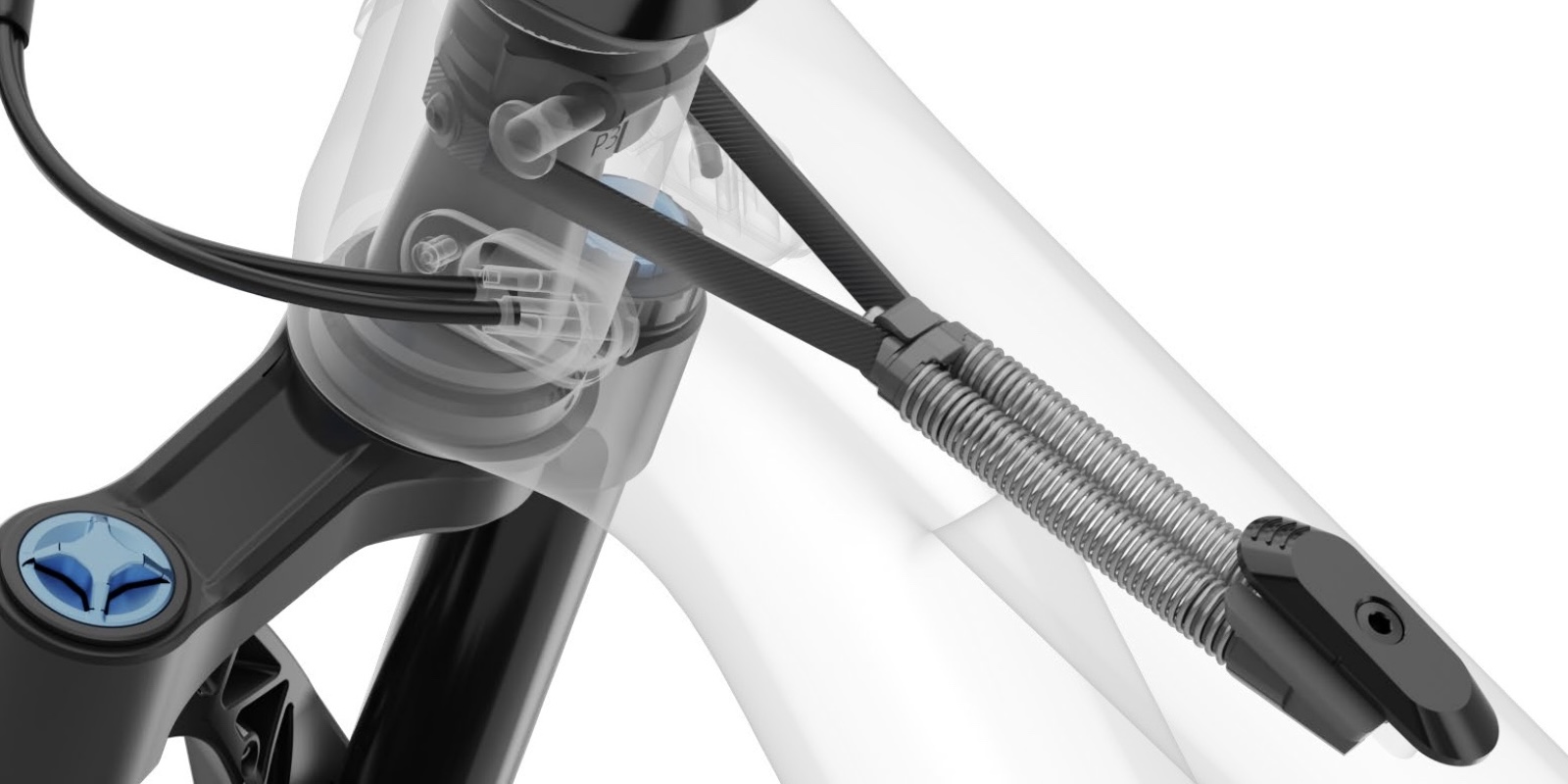
Verdict
I actually left it a bit to write my verdict because I wanted to sense check how outstanding I was saying this bike was. But if anything, a bit of extra reflection makes me love it even more. Every time I’ve ridden the Spectral it's injected so much infectious joy and poppy playfulness into the experience that it's changed how I’ve looked at the trail. And if you know how grim trail conditions are in the UK right now, that’s an amazing bit of vibe delivery.
Glorious frame feel is synced with superb suspension performance, really well sorted geometry and a pretty much perfect spec pick in terms of cost effective durability. My opinion of the optional steering intervention from the KIS spring system has gone from ‘a gimmicky waste of weight’ to ‘genuinely useful in some situations’. The ability to spec or run your Spectral twin 29er or MX and even fit a coil shock if you want is a valid and valuable thing too and the internal and external storage is really well executed. It’s loaded with practical durability features as well, so not only is it superb value as an initial investment, it should also be an excellent long term choice. Sure it’s a little on the heavy side for a full carbon bike, but that’ll probably be the last thing that’ll be on your mind when you’re riding it, even on technical climbs. Because not only does it still get on up extremely well, the way is carves, charges and charms on descents or singletrack is simply exceptional.
If you get the same underdog delight I do from riding a bike that’s better than most two or even three times it’s price, then the Spectral adds another level to the LOLs too. Don’t forget that however good the price, Canyon are launching it remotely into a landscape full of up to half price bikes being sold by your local shops, so weigh up those pros and cons too.

Test conditions
- Temperature: Minus 2 to 12 degrees C, mostly sopping wet but with some perfect loam days
- Surface: Man made red and black trail centre runs, woodsie off piste, moorland singletrack and old skool DH race tracks
Tech specs: Canyon Spectral CF 7 2024
- Discipline: Trail
- Price: $3,699 / £3,299 / €3,399
- Head angle: 64 degrees
- Frame material: Canyon CF carbon fiber
- Fork: Fox 36 Rhythm 150mm travel
- Shock: Fox Float X Performance 140mm travel
- Sizes: XS, S, M (tested), L, XL
- Weight: 15.36kg (medium)
- Wheel size: 29in
- Chainset: Shimano SLX 32T with Hollowtech II BB
- Rear mech: Shimano SLX 1x12
- Shifter: Shimano SLX
- Cassette: Shimano SLX 12-speed 10-51T
- Brakes: Shimano SLX 203mm rotors
- Tires: Maxxis Minion DHR II 29 x 2.4in MaxxTerra, EXO front and Maxxis Minion DHR II 29 x 2.4in MaxxTerra, EXO+ rear tires
- Wheels: DT Swiss M1900
- Bars: Canyon G5 AL 780mm width
- Stem: Canyon G5 40 mm
- Grips: Canyon G5 lock on
- Seatpost: Canyon G5 34.9 x 170mm dropper
- Saddle: Ergon Enduro

Guy Kesteven has been working on Bike Perfect since its launch in 2019. He started writing and testing for bike mags in 1996. Since then he’s written several million words about several thousand test bikes and a ridiculous amount of riding gear. He’s also penned a handful of bike-related books and he reviews MTBs over on YouTube.
Current rides: Cervelo ZFS-5, Specialized Chisel, custom Nicolai enduro tandem, Landescape/Swallow custom gravel tandem
Height: 180cm
Weight: 69kg
